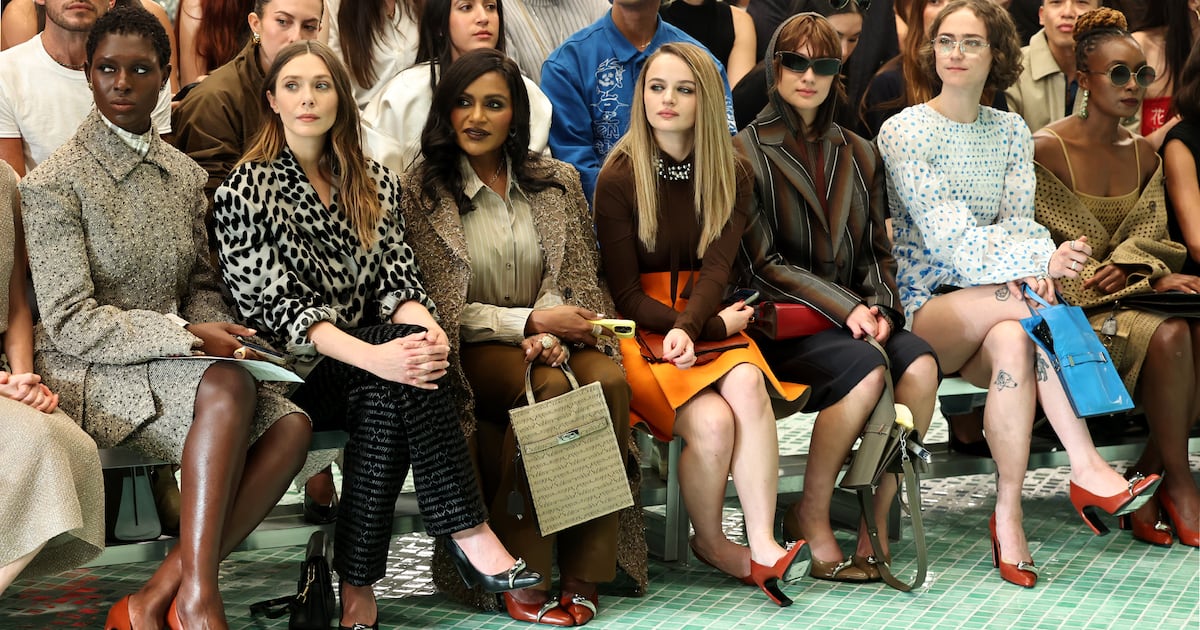Itâs a well known, but often unspoken fact: the primary purpose of fashion shows today is to sell accessories. But lately, some brands are getting a little more blatant about it.
Chloé kicked it off in February with a front row full of the brandâs Maxime Wedges at creative director Chemena Kamaliâs debut in February. The visual impact led to the likes of Elle and Vogue declaring âboho is back!â and âwedges are in again.â And then in September, Tory Burch staged its own shoe coup, dressing its high-profile guests â including actresses Mindy Kaling, Elizabeth Olsen and Michelle Williams â in its pierced heel, a buzzy style the brand is trying to turn into its next sales driver. The praises followed: Elle, WhoWhatWear and InStyle declared it an âitâ shoe.
The images â the same pair of shoes one right after the other â stood in stark contrast to luxuryâs typical front row strategy, filling front rows with VIPs in carefully coordinated looks that display a full range of items.
The gambit itself, though â flooding a scene with a product to create a sense of hype and sudden inescapability â isnât new. In 2018, Dior saturated the internet with saddle bags, seeding them to a sea of influencers for creative director Maria Grazia Chiuriâs big relaunch of the style. After showing its micro-mini skirt on the runway in October 2022, a slew of influencers arrived at Miu Miuâs next show in variation of the look. By then, it was already on its way to peak virality: it was on covers (Nicole Kidman on Vanity Fair, Paloma Elsesser on i-D), in campaigns (Hailey Bieber wore it in a series of ads for the brand) and on countless celebrities, including Zendaya, Hunter Schafer, Emily Ratajkowski, Chiara Ferragni and Saweetie.
Staging a product blitz can create a frenzy thatâs irresistible to social media algorithms; the press latches on to the storyline, too. At the same time, the tactic can be tricky in a luxury space driven by exclusivity.
Beyond the most obvious examples, the renaissance of the strategy plays into wider shifts. More brands are focusing on how to best use shows â and, specifically, product placement through VIP guest dressing â to spur sales. At a time luxury is widely under pressure, many brands are in need of a boost that fast-spreading imagery highlighting key products can provide.
âThereâs been a huge rise in discussion [among shoppers] about it-items and it-styles of the season,â said Gab Waller, a luxury product sourcer. âMost brands are trying to create that moment.â
Risks and Rewards
If a product blitz hits, it can drive awareness for a brand broadly and quickly. Chloé’s viral wedges, for example, helped hammer home a singular vision of who the Chloé girl is under its new creative director, and drive eyes to the collection itself. At Tory Burch, in the midst of a turnaround dubbed âthe Toryssance,â the ubiquity of pierced shoes helped create a sense of a clubbiness around the brand in general â InStyle called it âthe viral Tory-verse.â
A sense of a brand being its own world â i.e. that there is a Chloé girl or a Miu Miu girl â reflects how younger shoppers especially experience brands today, including with a desire to dress on âtheme,â said Allison Bringe, chief marketing officer of analytics firm Launchmetrics.
Still, manufacturing saturation comes with a risk that at some âpoint [it] becomes cheesy,â said Conor Begley, chief strategy officer at influencer marketing firm CreatorIQ.
Getting an item everywhere all at once can create excitement; but a brand canât live on excitement alone. Chloeâs wedges and Toryâs heels only make up a tiny fraction of conversation about both brands, said Begley, and the impact of these moments tends to be short lived. After the Chloe show, searches for âwedge heelsâ shot up 235 percent in the following week, but quickly returned to its baseline, according to fashion data firm Trendalytics.
In an effort to fast-track popularity, a brand could actually end up accelerating the shelf life of an item, especially among certain audiences. âA lot of clients shy away from something thatâs saturated,â said Waller. Consumers want things that seem illusive: if an item is suddenly everywhere itâs rarer that it develops that lasting it-item sheen, she added.
Waller didnât see a lot of demand for the Chloé wedge from her followers, mostly fashion enthusiasts in the US, she said. A blitz is more likely to resonate with a consumer on the accessible end of the spectrum, said Laurent Francois, managing partner at Paris-based creative agency 180 Global.
âYouâre going to reach a wide audience, it creates an amazing picture, suddenly you make an impact,â said Francois. âItâs smart in the short term, but when you look at what true luxury consumers want from luxury brands itâs an elevation of product.â
Most importantly, people have to actually want to wear the item thatâs being pushed: âThereâs a risk in being too impactful without credibility or without general interest to wear the stuff,â said Francois.
Perhaps thatâs why most brands take a more subtle approach. Fendi, for example, fronted its new version of the soft Peek-a-Boo bag, launched in August, at its show: it was on the runway, a number of VIP guests including actress Shaliene Woodley, singer Normani and influencer Caroline Daur carried it, and Fendi dedicated most of its Instagram posts in the days that followed to the bag. It didnât make for a mega-viral moment, but there was a clear push around a bag already available for purchase, said Bringe.
âFashion week is a great place to amplify whatever product youâre selling. But if you donât specifically talk about that product within the context of fashion week, no ones going to know youâre promoting it,â said Bringe. âThatâs something weâve seen brands get smarter at.â

